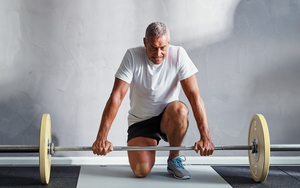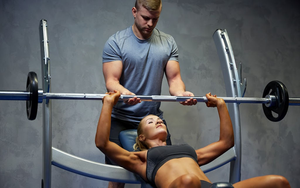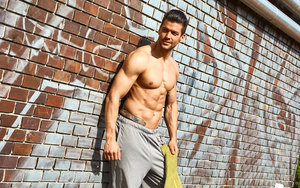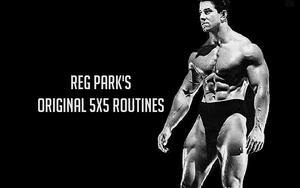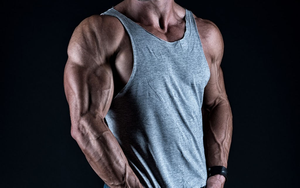
The Ultimate Minimalist Home Workout
All you really need are these five simple exercises which work every muscle group that you can do anywhere with just a set of dumbbells - in other words, a "minimalist workout".
If all you have is a set of one or two of dumbbells, you can not only get a challenging workout but also one of the most efficient ones that you can do at home or anywhere you want.
Aside from building a more muscular and aesthetic physique and increased overall fitness, one of the best benefits of incorporating dumbbell and bodyweight movements is the overall improvement to mobility and natural movement patterns. Selecting exercises which have a carryover into everyday activities is a very good approach in designing a good workout routine.
Having a strong core and the ability of carrying a load in each hand up the stairs for example are benefited by functional movements such as bridges, push-ups, high plank dumbbell rows and step-ups.
Constructing a workout routine of five simple exercises with minimal gym equipment, combining upper body pushing and pulling with a squat and a hinge movement to hit every major muscle group three times a week is all that one needs for lifelong fitness, strength, and muscular development.
The Ultimate Minimalist Home Workout
- Racked Kettlebell or Dumbbell Front Squat
- Hand Release Push up
- Plank Kettlebell or Dumbbell Rows
- Table Bridge
- Kettlebell or Dumbbell Step-Up
There are two different ways you could set this up. For more of a strength focus you could work through each movement in the traditional manner doing one after the other, or for a conditioning focus, do circuits of each movement after another with little rest in between until all five exercises are completed and the run through it 3-5 times like this.
I would suggest doing 3-5 sets of 10-15 reps of each exercise in any event and if you are doing circuits, rest 15-20 seconds between each movement. How much weight you use depends on picking a weight that keeps you in this range. Myself, I use two pairs of dumbbells, a set of rubber hex dumbbells in 35 and 50 pound sizes.
Racked Dumbbell Front Squat
Overall I find this movement easier to coach and learn than a goblet squat. It lends itself to better postural alignment and is a very quad centric movement where you can get the same depth as one could in a bodyweight or other squat. Feel free to use a low box to sit on if you feel that helps get used to it.
When holding the dumbbells there are different ways you can go about this. Some like to hold them as if in the contracted part of a dumbbell curl with the elbows tight against the core.
Myself, I like to rest the inner head of the dumbbell on the other part of my front delt and then contact my chest and elbows together to keep my core nice and tight. I find this especially good as the weights get heavier as it makes it easier to stabilize them.
Besides building strong quads, it also works all of the thigh and hip muscles as well as your core.
Hand Release Pushup
Very recently the military starting using this push-up method in their fitness testing. I really like it as it forces one to do full reps with no cheating and completely takes momentum out of it.
The push-up is one of the easiest and safest ways to build bigger and stronger chest, shoulder and triceps without the risk of injury that come with bench presses for example as it is a self-limiting movement.
What I've found beneficial to load each rep is to concentrate on squeezing your shoulder blades together when your palms come off of the floor, as it primes the pushing off of the floor.
Plank Dumbbell Rows
Also known as "Renegade Rows", I really like this one. A lot of experts would argue that rows are actually more important as far as long-term shoulder health goes than pullups.
Although you obviously can't use the same weights you would in heavy one-arm dumbbell rows, you can still scorch your upper back as well as build great core strength with it. There are also variations such as "Bear Rows" which you can look into as well.
It is a very complete movement as it hits the back and core from multiple angles. The key here is to resist the urge to rotate your torso, keeping as stable as possible.
You can either do all of the reps one arm at a time or alternate from side to side. Without a doubt, plank rows are a great test of core strength.
Table Bridge
One of the most essential and underrated bodyweight exercises is a bridge. A so-called table bridge is easy to learn in stages and works your glutes, hamstrings, hip flexors, and stretches the psoas and other core muscles as well as anterior delts, biceps and wrists.
I like to do the eccentric and concentric parts of table bridges to a 4 second count and hold the bridge for ten seconds. This greatly helps with shoulder and back flexibility.
The key to the table bridge is, as with hip thrusts or other bridge, is to concentrate on the contraction in your glutes as the prime mover. Feel the squeeze and tension as you come up into a horizontal torso, parallel with the floor.
For many of us working from home and maybe sitting more than ever, it will work wonders addressing all the time we spend in a forward flexion position.
Step-Up
Not only do we not get enough unilateral movements, particularly in our lower body, most athletic as well as daily activities are unilateral: running, jumping, climbing etc.
One of the movements with the most carryover into daily life is the step-up. (think of doing even simple things like carry groceries up the stairs). There is perhaps no better exercise to develop both horizontal and vertical leg drive.
Eastern European and Soviet trainers were using step-ups with their athletes before anyone else were.
One simple tweak for anyone with knee issues is to do a reverse step up, where instead of beginning with one leg on a box and the other on the floor, begin with standing on a box and then stepping down, so that you don't start with a pure concentric contraction on the working leg.
Final thoughts
If you want to increase the conditioning aspect of this routine you can do 30 seconds of jumping jacks, running in place or jump rope in between sets as well. Let me know in the comments what you think.

